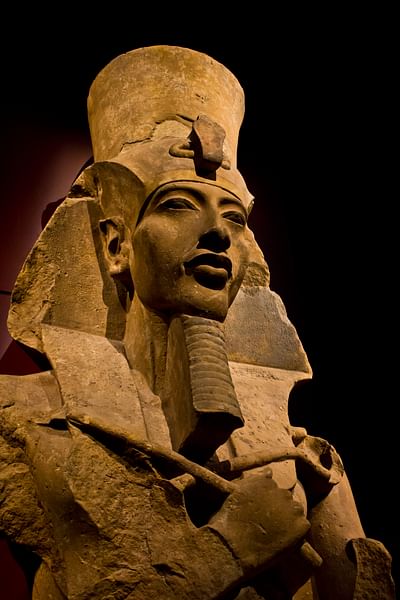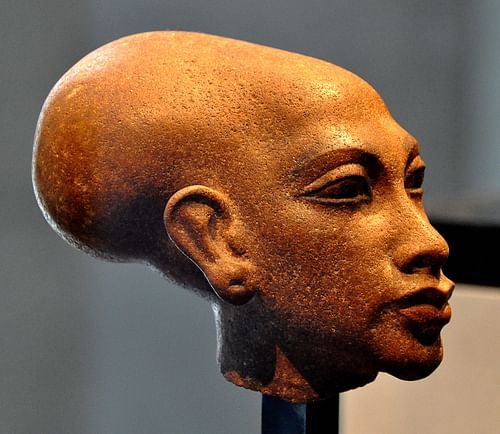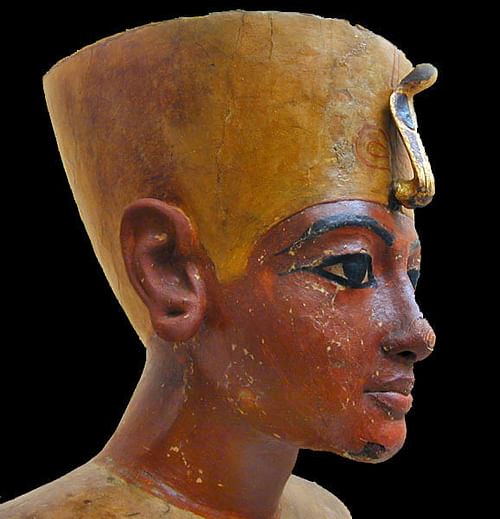How Did the Style and Content of Egyptian Art Change During the Amarna Period?
Of all the pharaohs who ruled ancient Arab republic of egypt, in that location is one in particular that stands out from the balance. Over the course of his 17-year reign (1353-1336 BCE), Akhenaten spearheaded a cultural, religious, and artistic revolution that rattled the country, throwing thousands of years of tradition out the window and imposing a new world order. After his death his proper name was omitted from the king lists, his images desecrated and destroyed. From the surviving fragments of prove, Egyptologists have pieced together the story of his life and reign, a catamenia of spiritual upheaval and experimentation unlike any other in Egyptian history. Under his supervision, Egyptian art underwent a monumental transformation, with centuries of rigid convention abandoned in favor of a new, highly stylized creative arroyo imbued with divine meaning.

Statue of Akhenaten
EARLY REIGN OF AMENHOTEP IV
The second son of Pharaoh Amenhotep Iii, Akhenaten (originally Amenhotep IV) was never meant to be king. His elder brother, Prince Thutmose, was heir apparent, but after his untimely demise, young Amenhotep found himself thrust into the political spotlight. Following a cursory period of co-regency, Amenhotep III died in 1353 BCE, and Amenhotep IV ascended to the throne. With his Great Wife Nefertiti by his side, the new pharaoh began what appeared to be a conventional reign: he dedicated monuments to Amun, added to the temple complex at Karnak, and even held a Sed festival in Regnal Year 3. Yet, Amenhotep 4's dominion was anything but ordinary, and shortly the rex began to let his true colors show. The pharaoh was a fanatical devotee of Aten, a deity representing the physical form of the sunday disk. Different most other Egyptian gods and goddesses, Aten had no human characteristics and took no anthropomorphic form. Under Amenhotep's direction, this fringe cult soon became the largest religious sect in Egypt.
In Regnal Twelvemonth v, the pharaoh dropped all pretense & declared Aten the official state deity of Egypt.
In Regnal Year 5, the pharaoh dropped all pretense and declared Aten the official land deity of Egypt, directing focus and funding abroad from the Amun priesthood to the cult of the dominicus deejay. He even changed his name from Amenhotep ('Amun is Satisfied') to Akhenaten ('Effective for the Aten,') and ordered the construction of a new uppercase urban center, Akhetaten ('The Horizon of Aten') in the desert. Located at the mod site of Tell el-Amarna, Akhetaten was situated between the ancient Egyptian cities of Thebes and Memphis on the eastward bank of the Nile.
ARCHITECTURE OF THE AMARNA Menses
Not long after coming to power, Akhenaten/Amenhotep Four deputed the construction of a new temple circuitous adjacent to the one at Karnak (modern-twenty-four hours Luxor). This new project, nevertheless, was a completely separate entity from the temple to Amun, made clear past the fact that the site was located outside of Karnak's perimeter. Named Gempaaten ('The Aten is Institute'), Amenhotep'due south new temple complex was unlike whatever that had come before information technology. Instead of being comprised of individual, closed-in sanctuaries, the open up-air courtyards at Gempaaten allowed Aten's sunlight to flow directly into the complex.

Smaller Aten Temple, Amarna
Following in the footsteps of Gempaaten, the Dandy Aten Temple in Amarna was another prime example of an "open-air" temple. Surrounded by a large enclosure wall, the temple circuitous consisted of two chief structures: the Sanctuary, located in the eastern section of the complex, and the Long Temple, located in the western department. The fact that this temple was arranged on an east-west axis was itself a nod to the path that Aten took across the heaven each twenty-four hour period. The Sanctuary was equanimous of two courts, the second of which was open up to the air and housed the chantry where Akhenaten and Nefertiti would present their private offerings to the sun disk. The Long Temple consisted of a columned court and more than 900 modest, open up-air altars where priests would burn down offerings to the Aten. N of the Great Aten Temple was a second, smaller temple, situated in the center of Amarna closer to the palace and king'south royal residence. This second temple as well followed the layout of Gempaaten and the Great Aten Temple, synthetic so that it was exposed to direct sunlight at all times.
Amarna'due south multiple palaces were constructed of mudbrick and painted with colorful, highly decorative scenes of plants, wild fauna, and the imperial family. These structures included many open courts and columned porticos, also equally big courtyards decorated with colossal rock statues of Akhenaten and Nefertiti.
PORTRAITURE OF AKHENATEN
Artifacts from Akhenaten's reign are instantly recognizable for their unique artistic style. Among the most hitting of these pieces are those depicting the male monarch himself, many of which have lead Egyptologists to question the land of the pharaoh'southward health and physical appearance. A prime instance comes from Gempaaten: an enormous, total-trunk statue of Akhenaten exhibiting some peculiar characteristics. The king's face is long and thin, with slit optics and large, full lips. His figure is equally strange and out-of-proportion, with spindly arms, long fingers, a paunch, and feminine hips and breasts. This particular statue is fragmentary, cutting the pharaoh off at the knees, but from other depictions of Akhenaten that take survived, it can be inferred that the pharaoh's legs tapered out from large thighs to thin calves ending in elongated anxiety. At first glance, such a statue is shocking, as information technology strays so far from the path of typical Egyptian artistic convention. Instead of presenting the image of a immature, fit, virile king, artistic representations of Akhenaten convey a very different message. With such strange actual proportions and facial features, the pharaoh comes across as weak, sickly, and effeminate.

Colossal Statue of Amenhotep 4
Why did Akhenaten choose to be presented to his subjects like this? As pharaoh, he had complete command over the production and distribution of artwork and, therefore, was certainly the driving force behind such bold artistic choices. Statues like the Gempaaten colossi have acquired many historians to speculate nigh Akhenaten's life and the possibility of the pharaoh being affected by a genetic disorder. Generations of inbreeding and brother-sis marriages during the 18th Dynasty make this theory a very existent possibility. Withal, most Egyptologists contend that Akhenaten's hitting visage has more to do with religious symbolism than capturing the king'due south literal concrete likeness.
Like many of his predecessors, Akhenaten believed himself to be a living god. While most Egyptian pharaohs aligned themselves with the gods of the traditional Egyptian pantheon such as Horus, Akhenaten fittingly decided to associate himself with Aten; one of the king's many epithets was 'The Dazzling Aten,' and he believed himself to exist the lord's day disk's concrete manifestation on earth. Unlike other Egyptian deities, Aten was neuter; the sun disk was a physical object with no discernable sexual practice. It is reasonable to believe, therefore, that Akhenaten (a form of the deity itself) chose to depict himself in a similarly androgynous way. Historical and archaeological prove has conspicuously proven that Akhenaten was a fertile male (he had at least six daughters and 1 son), only the inclusion of such striking female person traits in artistic depictions of the king sent a powerful message, connecting the pharaoh to the essence of Aten itself.

Queen Nefertiti
Over the form of Akhenaten's reign, information technology is known that at to the lowest degree 2 dissimilar sculptors were employed in the service of the rex. The showtime, a man named Bak, is mainly credited with the earliest and near radical Amarna-style pieces (i.east. the Gempaaten colossi). Information technology has been suggested the catamenia immediately post-obit Regnal Year 5 served equally a sort of "experimentation period" in which Akhenaten tried to push the boundaries of Egyptian artistic convention as far as he could, equally a result producing some of the most radical and stylized pieces of the Amarna Period. In the later on years of Akhenaten's dominion, Bak was replaced by another sculptor, Thutmose, who had a more measured approach to his piece of work. Items recovered from Thutmose'due south workshop bear witness that the sculptor favored a more realistic, less-exaggerated style than his predecessor, best exemplified past his iconic bust of Nefertiti on display in Berlin.
IMAGES OF NEFERTITI & THE Majestic FAMILY
One of the well-nigh touching and fascinating aspects of art during the Amarna Period is how Akhenaten and his family presented themselves. In traditional Egyptian artwork, the figures are commonly quite strong and composed, often depicted participating in solemn religious ceremonies or political events. Seldom were the royal family shown in a casual setting, spending time together in scenes from their daily life. During the reign of Akhenaten, yet, all this changed. The pharaoh was almost ever accompanied by his daughters, and his Great Wife Nefertiti was always past his side. The family was frequently shown offering to the Aten, but there are also scenes of the royal family eating together and relaxing in the palace. The immature princesses were often captured playing around their parents' thrones, or cradled in their laps. Nefertiti (and her daughters) were also painted with the aforementioned red ochre skin tone as her married man, a color typically reserved for males, and, along with the pharaoh, had unusually detailed hands and feet (before this point, the Egyptians had made no effort to distinguish between right and left appendages).

Akhenaten & Nefertiti
There exist countless stelae and carvings of Akhenaten and Nefertiti doting on 1 another and holding hands: in one example the queen even sits on her married man's lap. The couple too frequently appears in relief scenes showing them riding chariots together and bestowing gifts on their discipline from the "Window of Appearances" in their Amarna palace. This kind of affectionate, realistically-casual portrayal of a pharaoh was unprecedented in Egyptian history.
Similarly unheard of was the symbolic precedence given to Queen Nefertiti in the art of the Amarna Period. Instead of being portrayed as a scaled-down female figure standing behind her husband, Nefertiti was frequently presented at the same scale equally Akhenaten, a assuming artistic choice denoting her great importance and influence in court. And of import she was: during the last few years of Akhenaten's reign, he appointed Nefertiti equally his official co-regent, essentially making her a second king of Egypt on completely equal ground with him.

Akhenaten and the Royal Family Blessed by Aten
To further emphasize both her elevated position and the couple's close human relationship, early artistic depictions of Akhenaten and Nefertiti portray the rex and queen as near identical figures. Simply a few discrete markers existed to differentiate the two rulers, such as crowns (Akhenaten favored the k hat headdress while Nefertiti favored a apartment-topped blue crown), wig styles (variations of the cropped "Nubian-style" wig were popular with both hubby and wife), and the length and/or style of their garments. This bold choice was, once again, spurred on by religious symbolism.
By appearing as identical figures, Akhenaten and Nefertiti were aligning themselves with the twin deities Shu and Tefnut, respectively. Nefertiti's aforementioned flat-topped headdress was traditionally associated with the goddess Tefnut. Akhenaten clearly wanted to associate himself and his queen with these primordial creation deities, who, complementary to the Aten, represented forces of life and rebirth. The rex and queen, in essence, became the "Begetter" and "Female parent" of the world and heavens, putting them in a divine triad with Aten. Just as depictions of the pharaoh became more toned-downwards and realistic during the afterwards years of his reign, the tendency of the king and queen to appear as identical figures faded, although their divine association with the twin deities remained in identify.

Girl of Akhenaten
When it comes to the private tombs and monuments of Amarna'southward non-purple inhabitants, images of the royal family play an interesting role. Where once at that place would accept been images of Horus, Amun, Isis, and other traditional deities lining the walls of aristocracy burial chambers, at present stood images of Akhenaten, Nefertiti, and their children. Of form, images of Aten were e'er present, and the sunday disk ever took precedence over whatsoever human characters depicted aslope it. However, during the Amarna period images of the imperial family unit completely replaced images of the gods that had decorated Egyptian tombs for centuries. Fifty-fifty on the pharaoh'southward own rock sarcophagus, images of Nefertiti replaced those of traditional goddesses. Akhenaten, by associating himself with Shu and the Aten, and Nefertiti with Tefnut, had effectively presented himself and his family as living gods. What need was at that place, then, for images of other deities on the walls of his subjects' tombs? The pharaoh, his queen, and their offspring were a sacred extension of Aten on earth and therefore expected to be worshipped in their own right and to act every bit intermediaries between Aten and the common human being.
THE Terminate OF A DYNASTY
After 17 years on the throne, Pharaoh Akhenaten died in 1336 BCE. He was succeeded by the mysterious Smenkhkare (a curt-lived pharaoh many Egyptologists believe to have been Nefertiti), who in plough was succeeded by Akhenaten's young son Tutankhaten. Following Akhenaten'southward death, the Egyptian people were quick to voice their opposition to the "heretic" king's radical religious reforms. Favoring the stability of the old society, Tutankhaten moved the uppercase back to Memphis and reinstated the worship of Egypt'due south polytheistic pantheon. Within a few years, Amarna, Akhenaten's glorious 'Horizon of the Aten' had been completely abased, its king and queen buried and forgotten. In a further attempt to altitude himself from his father'southward legacy, the boy king changed his name from Tutankhaten ('The Living Image of Aten') to Tutankhamun ('The Living Prototype of Amun'). His wife and one-half-sister, Ankhesenpaaten, also followed suit, rebranding herself every bit Ankhesenamun ('Her Life is of Amun').

Tutankhamun
During his reign, Pharaoh Tutankhamun made not bad strides towards restoring Egypt to its pre-Amarna state, a campaign championed by the subsequent kings Ay and Horemheb. While Amarna-style art continued to be produced during this transitional period (particularly axiomatic in the murals decorating Tutankhamun's burial chamber), ultimately artistic tradition prevailed and Egyptian art from the 19th Dynasty and beyond largely adhered to historical conventions. With the death of Pharaoh Horemheb in 1292 BCE came the end of the 18th Dynasty itself: Horemheb's heir Ramesses I would found a new dynastic line, ushering Egypt into a golden age of military might and economic prosperity. In less than fifty years, nigh every trace of Akhenaten, his controversial reign, and the artistic conventions that defined it had been wiped from beingness.
This article has been reviewed for accuracy, reliability and adherence to academic standards prior to publication.
campbellaliesofely92.blogspot.com
Source: https://www.worldhistory.org/article/1110/the-art-of-the-amarna-period/
0 Response to "How Did the Style and Content of Egyptian Art Change During the Amarna Period?"
Post a Comment